ATV safety is necessary because all-terrain vehicles (ATVs) mainly ride off-road. Before riding an ATV, knowing ATV safety rules and wearing ATV protective gear is mandatory no matter how old you are.
Many people, especially teenagers, think ATVs are a toy, but ATVs are not a toy; they are powerful and potentially dangerous vehicles.
In most states in the United States, riding an ATV is legal, and teens can drive ATVs without a driver’s license. So, it’s easy to access an ATV; that’s why knowing proper ATV Safety tips will save ATV riders from accidents.
ATV Safety Tips
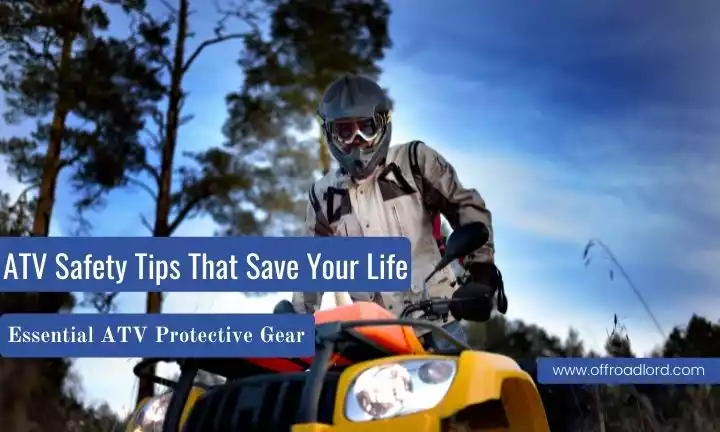
Although ATV laws vary from state to state, wearing ATV protective gear and avoiding riding ATV on paved roads are the most important ATV safety rules. Make sure you read your state ATV riding laws and follow them accordingly.
Here are 12 ATV safety tips to be safe on an ATV:
- Never Ride on Paved Road
- Do Not Drive ATV Under 16 Years Old
- Know the ATV Rules of Your State
- Never Carry Passengers on single-rider ATV
- Maintain Safe Speed Limit
- Wear a DOT-certified Helmet, Gloves, Long Pants, Goggles, and Long Sleeves
- Ride an ATV that Your Size and Age
- Never Drive a Three-wheeler ATVs
- Do Not Drive ATV Under the Influence of Alcohol or Drugs
- Ride on Designated Trails
- Take an ATV Safety Course
- Ride ATV on Daylight
1. Never Ride on Paved Road
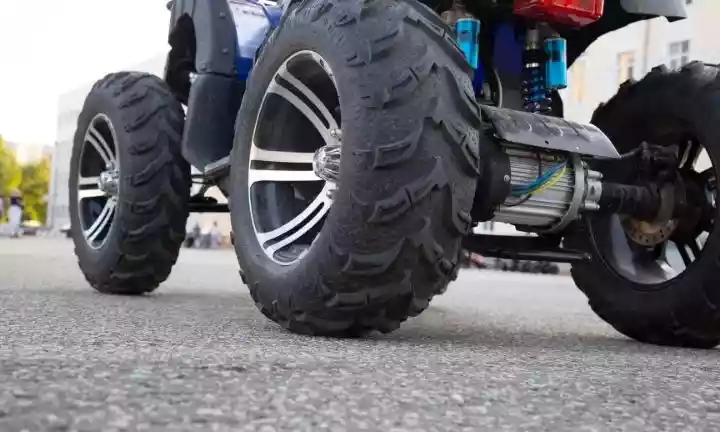
ATVs brands make ATVs only for off-road, not for paved roads. Riding ATVs on highways is also illegal because ATVs are not designed to be driven on highways.
ATVs are mainly used for recreation, agriculture, and construction work, but ATVs as a personal transpiration system on public streets or highways are not allowed.
You can cross the road if you need to, but keep in mind that vehicles on the highway are going so fast; that’s why you should cross your ATV as quickly as you can.
And before crossing the highway, ensure there are no vehicles towards you.
Related: Amphibious ATV Brands in 2025
2. Do Not Drive ATV Under 16 Years Old
As you know, ATVs are potentially dangerous vehicles, and handling an ATV is not easy for kids. That’s why for considering children’s health and safety, ATV operators must be 16 years old or older.
The ATV operator needs to speed up, speed down, turn the corner, jump the vehicle from time to time; that’s why it’s hard to control for anyone under 16 years old.
Proper skills and body strength is essential to driving a 4 wheeler because, handling a off-roading vehicle is harder than normal vehicles.
But, in recent years, several ATV manufacturers have been producing ATVs for 10 to 14 years kids. So, if you want to purchase ATVs for your kids, then consider a good quality youth ATV.
3. Know the ATV Rules of Your State
Whether you live in New York or Texas, every state has ATV rules, and as an ATV operator, you must know the rules. You can find your state ATV rules on CPSC government website.
Different rules for different states, but some fundamental ATV rules are applicable for every state in the United States.
Not only knowing your state ATV rules is not enough, but you must also follow them when you are driving an ATV.
Check Out: ATV Weight: Average ATV Weight, Chart
4. Never Carry Passengers on single-rider ATV
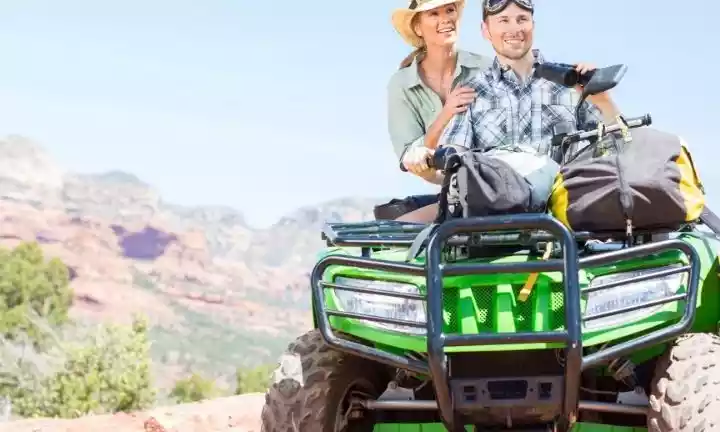
Most types of ATVs are made for only one person (ATV operator). But, there are also many ATVs designed for carrying passengers.
People make this mistake a lot, and they even carry a child on a single-rider ATV.
When you ride a single-rider ATV, do not carry someone with you because off-road is bumpy, and passengers and you might fall off the ATVs when ATVs are jumping.
So, make sure no passengers on single-rider ATVs. Overloading is also not good for ATV tire lifespan.
5. Maintain Safe Speed Limit
The top speed of an ATV is 80mph (128km/h), and it’s so fast for off-road. When you speed up your ATV, more speed leads the ATV to be hard to control, so eventually, more speed can put you in great danger.
Ride your ATV at a maintainable speed; at that speed, you can control your ATV.
On an ATV trail, your ATV’s speed can go high, but off-road, you must be careful of the speed of your ATV.
Fortunately, youth ATVs are equipped with a speed limiter that doesn’t let ATV drivers go too fast.
But, adult ATVs do not have any speed limiter option, so you need to control your ATV speed by yourself.
Related Article: Biggest Four-Wheelers
6. Wear a DOT-certified Helmet, Gloves, Long Pants, Goggles, and Long Sleeves
DOT-certified means the most basic and least margin of safety features. That’s why wearing DOT-certified ATV protective gear will keep you safe from accidents.
You must have DOT-certified ATV protective gear if you are an ATV owner.
Wear DOT-certified gloves, goggles, long sleeves, and most importantly DOT-certified helmet because the head is the main part of a human body, and a helmet will protect the head.
The price of DOT-certified ATV safety gear is a little higher than without DOT-certified protective gears but, go with DOT-certified safety gears because it’s more protective.
7. Ride An ATV According To Your Size And Age
When you are planning to buy or ride an ATV, you must drive an ATV that is for your size and age. There are various types and sizes of ATVs, such as large, standard, utility, small, and youth size.
If you are an adult, you should never ride a Youth or Children ATV because Youth ATVs are small and not capable of carrying adults.
Kids are only allowed to youth ATVs. If you are older than 16, then ride an adult ATV only.
You should drive a standard or large size ATV because its size and capacity meet your body requirements.
See Also: ATV Sizes Chart 2025
8. Never Drive A Three-wheeler ATVs
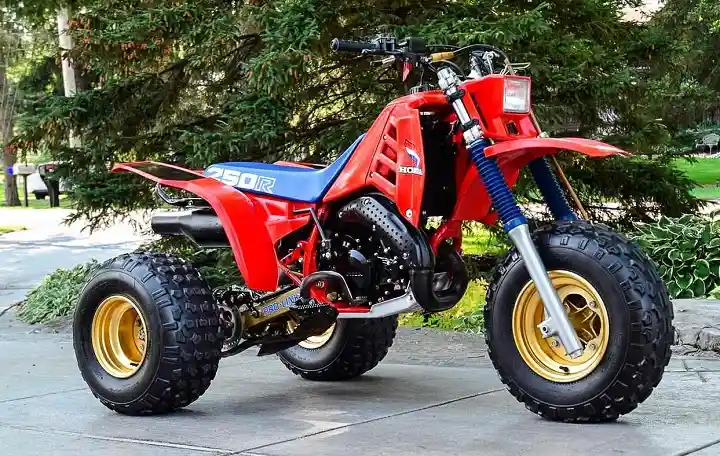
Since 1988, the United States government has banned selling new three-wheeler ATVs in the United States because of frequent injury.
The balance of Three-wheeler ATVs is not great; that’s why people get injured riding a 3-wheeler ATV.
Now it’s rare to see three-wheeler ATVs, but there are still some three-wheelers available. Do not try to drive a three-wheeler ATV because it’s not safe at all.
9. Do Not Drive ATV Under the Influence of Alcohol Or Drugs
All-terrain vehicles (ATVs) are for riding off-road but not on the street.
It’s not easy to control an ATV off-road. Avoid riding an ATV under the influence of alcohol or drugs; going to save you from a major injury.
Off-road trails contain various terrain conditions such as mud, rocky, and sand. That’s why it’s neutrally hard to control an ATV.
The possibility of getting into an accident goes too high when you drive an ATV after drinking alcohol.
10. Ride On Designated Trails
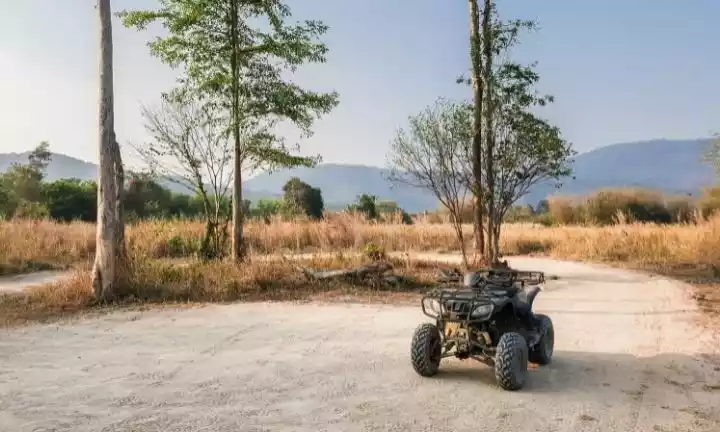
If you are a beginner-level ATV driver, you should not drive on off-road.
Designated ATV trails are safe for driving because, unlike extreme off-road, nothing can make your ATV imbalanced, so the chances of hitting something or falling off an ATV are less.
After gaining a certain level of experience, you will be able to go extreme off-road with your ATV, but before that, you must practice on designated ATV trails.
11. Take an ATV Safety Course
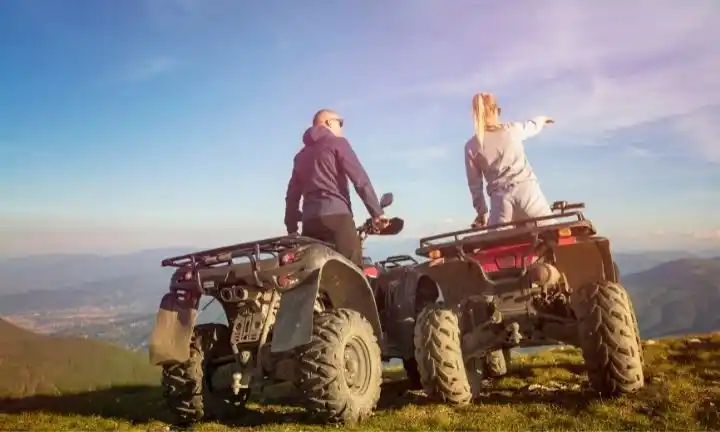
There is nothing more important than taking an ATV safety course to avoid any ATV injuries.
Whether you are an experienced ATV raider or beginner, you should take an ATV safety course.
ATV safety courses are now available on the internet, so you don’t need to go anywhere. Learn more about ATV safety and follow every ATV safety procedure to be safe on ATV.
12. Ride ATV on Daylight
Riding ATVs in the daylight is much safer than riding at night. Try to avoid driving an ATV at night because, at night, seeing the detail of the road is hard, so an ATV operator can get damaged by an unknown object easily.
But, in daylight, you can see every object on the road, so the chance of getting damaged will be less.
Sometimes you might need to ride an ATV at night, so in that case, you have to run the ATV slowly especially, when you turn the corner.
Essential ATV Protective Gear You Should Consider
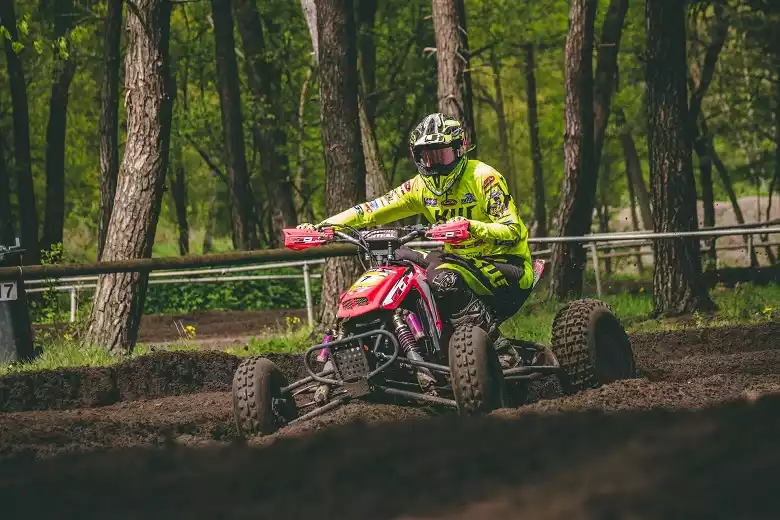
The ATV accidents and injury statistics always say how important ATV protective gears are.
More than 135,000 people are injured every year due to ATV accidents. For riding an ATV off-road, wearing ATV safety gear is necessary.
When you are riding an ATV off-road, you must be more careful about your body. ATV safety gear is a must to avoid ATVs injury whether you go to off-road or ATV trails.
The list of necessary ATV safety gears:
- DOT-certified Helmet
- Bionic Action Jacket
- Elbow Guards
- Knee Guards
- Neck Support
- Riding Shorts
- Kidney Belt
DOT-certified Helmet
A DOT-certified helmet is the most common ATV safety gear that you have to wear before reading your ATV.
Whether you are riding a bike or an ATV, you must wear a helmet before going to the road. DOT-certified helmets are more protective and safer than regular helmets.
Some ATV tire brands also make DOT-certified tires that you can buy for more safety.
Bionic Action Jacket
Bionic action jackets are an innovation for protecting riders’ bodies. Bionic action jackets are lightweight and properly ventilated.
Before riding your ATV, wearing a bionic action jacket will protect your body from extreme injury.
Elbow Guards
Elbow guards are another ATV protective gear that keeps your elbow safe. Getting hurt on the elbow is common in ATV accidents, so wearing elbow guards is necessary.
Knee Guards
Knee guards are also known as knee pads. Wearing knee guards will protect your knee from falling to the ground or hitting an obstacle. Wearing Knee Guards is more important when you are riding sports ATVs.
Neck Support
This ATV safety gear is really useful and protective, whether you call it neck support or neck brace. A neck brace will protect your shoulder from getting any injuries.
Riding Shorts
You might see motorcycle racers wearing riding shorts on TV. Although ATV riders do not normally wear riding shorts, they should.
Kidney Belt
If you’re an ATV rider, you must wear a kidney belt. A kidney belt supports your lower back in the whole off-road journey.
Try to get a good quality kidney belt and wear it before driving an ATV.
These are necessary ATV safety gears you have to have if you are an ATV driver. And, make sure you wear them before driving your ATV, especially before going off-roading.
ATV Safety Videos
ATV safety videos can also help you to stay safe on an ATV. So, I also share an ATV safety video here:
Can Kids Ride On Back Of ATV?
Kids are not safe on ATVs because ATVs are often driven off-road. Never ride ATVs with children that are younger than 6 year old, and you have to ensure kids wear ATV protective gear properly.
Youth model ATVs are manufactured for kids, and children need to be 16 or older to ride an ATV. So, keep your kids away from ATVs if they are not old enough.
Is It Safe To Ride An ATV While Pregnant?
You have to avoid riding an ATV while you are pregnant. While you are pregnant, do not go off-roading because it’s not safe for pregnancy.
Not only riding ATV, any types of off-roading and extreme activities you have to avoid while you are pregnant.
Why Is It A Bad Idea To Carry A Passenger On An ATV Designed For Only One Rider?
Never carry more than one passenger on an ATV that is designed for only one rider.
Most ATVs are manufactured for only one rider, only an ATV operator. When you carry a passenger on an ATV descended for only one rider, passengers can throw from the ATV anytime and anywhere.
ATVs can flip or fall off if you carry a passenger on an ATV that is designed for only one rider. That’s why avoid riding an ATV with two passengers, and it will save you both.
Final Thought – ATV safety
ATVs are not really easy controlling vehicles that a beginner can ride properly.
And whether you have experience of ATV riding or not, before riding an ATV, you have to know the ATV safety rules and tips properly.
Follow ATV safety tips on ATV trails and off-road. Avoid wearing ATV protective gears because sitting on an ATV, especially wearing a helmet, will protect your head from any injury.
Stay your kids away from ATVs because kids often make mistakes while riding an ATV. ATV size is another crucial thing to consider when choosing an ATV for riding.
Ensure you’re riding an ATV that is your size and if you are an adult, avoid riding a youth ATV.

Calvin Anderson, founder of Off-Road Lord, is a seasoned off-roading enthusiast from Tucson, Arizona. With over a decade of hands-on experience and a deep understanding of off-roading vehicles and trails, Calvin’s insights provide a trusted guide for fellow adventurers.